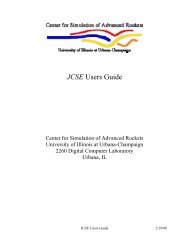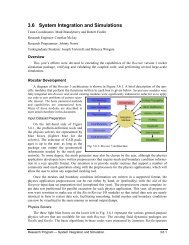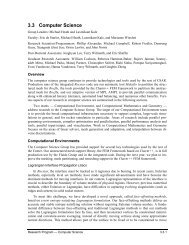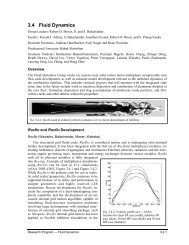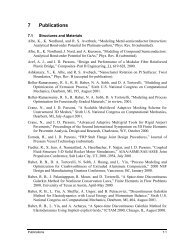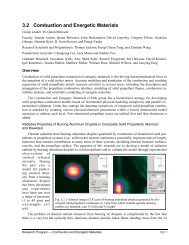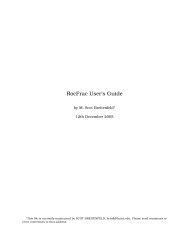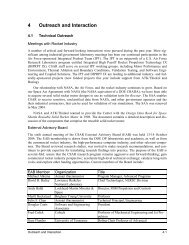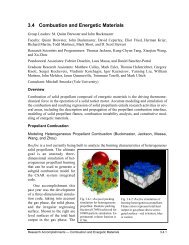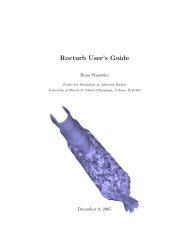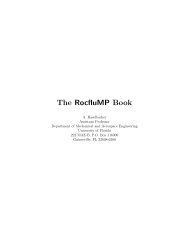3.4 Combustion and Energetic Materials - Center for Simulation of ...
3.4 Combustion and Energetic Materials - Center for Simulation of ...
3.4 Combustion and Energetic Materials - Center for Simulation of ...
Create successful ePaper yourself
Turn your PDF publications into a flip-book with our unique Google optimized e-Paper software.
<strong>3.4</strong> <strong>Combustion</strong> <strong>and</strong> <strong>Energetic</strong> <strong>Materials</strong><br />
Group Leaders: M. Quinn Brewster, John Buckmaster, <strong>and</strong> Herman Krier<br />
Faculty: Quinn Brewster, John Buckmaster, David Ceperley, Eliot Fried, Herman Krier,<br />
Richard Martin, Todd Martinez, Mark Short, <strong>and</strong> D. Scott Stewart<br />
Research Scientists <strong>and</strong> Programmers: Thomas Jackson, Lubos Mitas, <strong>and</strong> Kung-Chyun Tang<br />
Postdoctoral Associates: Fabrice Douchin, Abdelkarim Hegab, Min-Gyoo Lee, Daniel Sanchez-Portal,<br />
<strong>and</strong> Jin Yao<br />
Graduate Research Assistants: Gregory Knott, Sergei Kochevets, Vladimir Korchagin, Igor<br />
Kouznetsov, Yanning Liu, John Melcher, William Mattson, Burkhard Militzer, Jeffrey Murphy,<br />
Jason Quenneville, Bidhan Roy, <strong>and</strong> Tommaso Torelli<br />
Visitors: Luc Bauwens (University <strong>of</strong> Calgary, Canada), Claus Heerlein (Germany), <strong>and</strong> Sergei<br />
Surzhikov (Russian Academy <strong>of</strong> Sciences, Moscow, Russia)<br />
Consultant: Mitchell Smooke (Yale University)<br />
Overview<br />
<strong>Combustion</strong> <strong>of</strong> solid propellant composed <strong>of</strong> energetic materials is the driving thermomechanical<br />
<strong>for</strong>ce in the operation <strong>of</strong> a solid rocket motor. Accurate modeling <strong>and</strong> simulation<br />
<strong>of</strong> the combustion <strong>and</strong> resulting regression <strong>of</strong> solid propellants entails research activities in<br />
several areas, including the description <strong>and</strong> propagation <strong>of</strong> the propellant combustion interface,<br />
modeling <strong>of</strong> solid propellant flames, combustion instability analysis, <strong>and</strong> constitutive<br />
modeling <strong>of</strong> energetic materials.<br />
<strong>Combustion</strong> Interface<br />
The combustion region at the interface between the<br />
chamber flow <strong>and</strong> the propellant is thin, on the order<br />
<strong>of</strong> tens <strong>of</strong> microns. In contrast, the overall dimensions<br />
<strong>of</strong> the RSRM are measured in meters. Hence,<br />
the integrated system code must treat the combustion<br />
layer as an interface across which mass, momentum,<br />
<strong>and</strong> energy are given in terms <strong>of</strong> jump conditions.<br />
There are a number <strong>of</strong> strategies <strong>of</strong> varying sophistication<br />
with which to generate these conditions. The<br />
most detailed approach is the generation <strong>of</strong> a complete<br />
sub-grid combustion model (called Rocfire), a<br />
three-dimensional unsteady simulation <strong>of</strong> the propellant<br />
flames, the thermal layer in the solid, <strong>and</strong> the<br />
unsteady nonuni<strong>for</strong>m regression <strong>of</strong> the solid surface.<br />
This work is being carried out under the leadership<br />
<strong>of</strong> Buckmaster <strong>and</strong> Jackson. Three significant mile-<br />
Fig. <strong>3.4</strong>.1: Packing simulation <strong>for</strong> heterogeneous<br />
propellant. Realistic packing<br />
fraction (0.7698) achieved <strong>for</strong> 10000<br />
particle simulation. Experimental volume<br />
fraction is 0.766.<br />
stones have been achieved in Y3 in this area: a packing model <strong>for</strong> heterogeneous propellants<br />
has been developed; Rocfire has been implemented in the context <strong>of</strong> s<strong>and</strong>wich propellants;<br />
Research Accomplishments Ñ <strong>Combustion</strong> <strong>and</strong> <strong>Energetic</strong> <strong>Materials</strong> <strong>3.4</strong>.1
<strong>and</strong> Rocfire has been implemented in the context <strong>of</strong> a two-dimensional r<strong>and</strong>omly packed<br />
propellant.<br />
Typical solid rocket motor propellants, such as those used in the RSRM, are composed<br />
<strong>of</strong> particles <strong>of</strong> ammonium perchlorate (AP) <strong>and</strong> aluminum (Al) embedded in a fuel binder.<br />
Since the burning rate <strong>of</strong> a heterogeneous propellant is influenced by the propellant morphology<br />
<strong>and</strong> by the size <strong>and</strong> size-distribution <strong>of</strong> AP particles, a method <strong>for</strong> generating model<br />
morphologies is required. A strategy <strong>for</strong> doing thisÑa r<strong>and</strong>om packing algorithmÑhas been<br />
developed in collaboration with Knott. It is a seminal contribution to propellant studies. The<br />
models generated in this way consist <strong>of</strong> r<strong>and</strong>om distributions <strong>of</strong> varying size spheres in a periodic<br />
cube (Figure <strong>3.4</strong>.1).<br />
The packing fractions (volume percent <strong>of</strong> AP) generated by the algorithm have been<br />
successfully compared with existing experimental data <strong>for</strong> bimodal packs. In addition, industrial<br />
AP data (obtained from R. Bennett <strong>of</strong> Thiokol Corporation) has been used by<br />
Kochevets to define realistic packs with packing fractions that closely approximate those <strong>of</strong><br />
true propellants. Future work includes modifying the algorithm to run on parallel plat<strong>for</strong>ms<br />
(necessary to generate packs with 100,000 or more particles), testing the code against an extensive<br />
experimental database, determining the overall statistics <strong>of</strong> the various packs, <strong>and</strong><br />
identifying pack-defined length <strong>and</strong> time scales that might interact with rocket chamber gas<br />
flow processes.<br />
R<strong>and</strong>om propellant packs generated by the packing algorithm can support a complex<br />
three-dimensional combustion field that is coupled to thermal processes in the solid. Rocfire<br />
is concerned with the detailed simulation <strong>of</strong> this field, <strong>and</strong> a preliminary version <strong>of</strong> Rocfire<br />
has been generated in collaboration with Hegab. The code describes the unsteady burning <strong>of</strong><br />
a heterogeneous propellant by simultaneously solving the combustion field in the gas-phase<br />
<strong>and</strong> the thermal field in the solid-phase, with appropriate jump conditions across the gas/solid<br />
interface. The model accounts <strong>for</strong> propagation <strong>of</strong> the nonuni<strong>for</strong>m surface, the AP decomposition<br />
flame, reaction between the AP products <strong>and</strong> the binder gases, different material properties<br />
<strong>of</strong> the AP <strong>and</strong> binder,<br />
temperature-dependent gasphase<br />
transport properties, <strong>and</strong> a<br />
full accounting <strong>of</strong> the equations<br />
<strong>of</strong> motion. No calculations <strong>of</strong><br />
this kind have been described<br />
be<strong>for</strong>e in the literature.<br />
A periodic s<strong>and</strong>wich propellant<br />
consisting <strong>of</strong> alternating<br />
slices <strong>of</strong> AP <strong>and</strong> binder has been<br />
used as a plat<strong>for</strong>m <strong>for</strong> developing<br />
the model <strong>and</strong> <strong>for</strong> the exploration<br />
<strong>of</strong> basic propellantburning<br />
physics. Figure <strong>3.4</strong>.2<br />
shows the retreating surface at<br />
various times, <strong>and</strong> the flames<br />
responsible <strong>for</strong> this regression.<br />
Following initial transients, the<br />
Fig. <strong>3.4</strong>.2: Heat contours in gas phase at several times (t = 0.0642,<br />
0.2785, 1.1412, 2.1357). Light gray is AP, binder is black.<br />
Research Accomplishments Ñ <strong>Combustion</strong> <strong>and</strong> <strong>Energetic</strong> <strong>Materials</strong> <strong>3.4</strong>.2
egression is steady, with unchanging shape. Calculations <strong>of</strong> this nature have enabled us to<br />
explore the effects <strong>of</strong> pressure, stoichiometry, s<strong>and</strong>wich thickness, <strong>and</strong> other parameters on<br />
the overall burning rate.<br />
Non-periodic s<strong>and</strong>wich propellants<br />
have been studied in the laboratory,<br />
but rocket flames need to be examined<br />
in the context <strong>of</strong> r<strong>and</strong>om particle<br />
packings. The first implementation<br />
<strong>of</strong> ROCFIRE in this context is <strong>for</strong> twodimensional<br />
packs where the AP particles<br />
are treated as disks, so that the<br />
combustion field is two-dimensional.<br />
This work is being done in collaboration<br />
with Hegab <strong>and</strong> M. Ulrich (AAE<br />
graduate student), <strong>and</strong> is also seminal<br />
in nature. Results <strong>of</strong> a typical calculation<br />
are shown in Figure <strong>3.4</strong>.3, where<br />
the reaction rate <strong>and</strong> fuel contours are<br />
plotted at an instant <strong>of</strong> time. These calculations permit the prediction <strong>of</strong> morphology-induced<br />
fluctuations in the burning rate, the effects <strong>of</strong> the AP size distribution on the average burning<br />
rate, the response <strong>of</strong> the burning rate to chamber pressure disturbances, etc. In the future this<br />
will be done in a three-dimensional context <strong>for</strong> which ASCI level resources will be needed.<br />
More in<strong>for</strong>mation about Rocfire, including several movies, can be found at<br />
http://csar.uiuc.edu/~tlj/rocfire.html.<br />
Homogenization<br />
Fig. <strong>3.4</strong>.3: Burning characteristics <strong>of</strong> 2-D particle pack<br />
Ñ reaction rate on left, fuel contours on right. Gray<br />
disks are AP particles, binder is yellow.<br />
Brewster <strong>and</strong> Tang are examining a simpler strategy <strong>for</strong> dealing with the combustion interface<br />
between the chamber gas flow <strong>and</strong> the bulk solid, one that essentially corresponds to a<br />
homogenization <strong>of</strong> the Rocfire picture. Both the combustion field <strong>and</strong> the thermal field in the<br />
solid are described by one-dimensional physics. The result is a relatively simple <strong>for</strong>mulation<br />
<strong>for</strong> the interface jump conditions that preserves some <strong>of</strong> the important physics <strong>and</strong> can provide<br />
a useful interim interface description while Rocfire is further developed. On slow time<br />
scales the description is a steady one, <strong>and</strong> yields the familiar c = Ap n <strong>for</strong>mula relating the regression<br />
rate, c, to the pressure. But at shorter time scales the transient storage <strong>of</strong> energy in<br />
the solid is accounted <strong>for</strong> by numerical solution <strong>of</strong> the one-dimensional unsteady heat conduction<br />
equation, <strong>and</strong> then the response <strong>of</strong> the burning rate to transients is richer. This model<br />
has been used to study the combustion-fluid coupling in a simplified composite propellant L*<br />
combustor, <strong>and</strong> shows that the difference between an unsteady description <strong>and</strong> the quasisteady<br />
description can be significant when the pressure changes rapidly with time.<br />
Figure <strong>3.4</strong>.4 compares tactical motor pressure histories employing this model. The unsteady<br />
burning rate is significantly larger than the quasi-steady burning rate during the initial<br />
pressurization stage <strong>of</strong> the burn; the unsteady burning rate model is able to simulate the observed<br />
initial pressure, while the quasi-steady burning rate model fails to do so. The results<br />
suggest that, contrary to conjecture in the literature, the rapid rate <strong>of</strong> initial pressurization <strong>and</strong><br />
Research Accomplishments Ñ <strong>Combustion</strong> <strong>and</strong> <strong>Energetic</strong> <strong>Materials</strong> <strong>3.4</strong>.3
the ÒignitionÓ spike are not due to<br />
erosive burning or other complicated<br />
fluid <strong>and</strong> flame dynamical<br />
effects.<br />
The dynamic regression rate<br />
model development, validation, <strong>and</strong><br />
integration will continue, with the<br />
first priority being implementation<br />
<strong>of</strong> a new model (Rocburn) into the<br />
integrated simulation codes<br />
(Rocface, Rocflo, <strong>and</strong> Rocsolid).<br />
Model development <strong>and</strong> validation<br />
will also continue with emphasis on<br />
validation <strong>for</strong> composite propellant<br />
combustion. Refinement <strong>of</strong> the empirically-based<br />
gas phase model to<br />
better represent the composite pro-<br />
pellant combustion behavior is being conducted. Dynamic burning conditions, such as beginning<br />
<strong>and</strong> ending transients <strong>and</strong> unsteady oscillatory burning, will be investigated.<br />
Fried <strong>and</strong> Short are adopting a third strategy <strong>for</strong> assessing the jump conditions across<br />
the combustion interface, one that does not make assumptions about the interface structure<br />
but rather uses the tools <strong>of</strong> modern continuum mechanics to develop thermodynamically consistent<br />
conditions <strong>and</strong> constitutive relationships. Their research has focused on incorporating<br />
aspects <strong>of</strong> interfacial structure in a thermodynamically consistent <strong>and</strong> properly invariant<br />
model <strong>for</strong> a combustion layer as a sharp nonmaterial interface. This model includes three additional<br />
interface conditions. These conditions determine the interfacial energy release, the<br />
interfacial friction, <strong>and</strong> the interfacial heating constitutively as functions <strong>of</strong> the interfacial<br />
mass flux, the interfacial velocity slip, <strong>and</strong> the interfacial temperature jump. As such, they<br />
embody the microphysical mechanisms associated with the change <strong>of</strong> phase <strong>and</strong> chemistry<br />
that occurs across the interface. In the simplest situation, when the interfacial free-energy<br />
density is constant, the relation determining the interfacial energy release contains a term associated<br />
with surface tension. This relation yields an evolution equation that is directly<br />
analogous to those arising in asymptotic models. Another feature <strong>of</strong> this theory is that it accounts<br />
<strong>for</strong> the transient addition <strong>of</strong> mass to the combustion layer.<br />
In the future the research will focus on obtaining a correspondence between the supplemental<br />
interface equations that arise in this generalized theory <strong>and</strong> the interfacial evolution<br />
equations that are used conventionally by scientists in the combustion community. An<br />
ef<strong>for</strong>t will be made to develop numerical methods <strong>for</strong> the solution <strong>of</strong> simple problems suggested<br />
by the theory.<br />
Flame Modeling Ef<strong>for</strong>ts<br />
P (atm)<br />
time (sec)<br />
0<br />
0<br />
0 0.02 0.04 0.06 0.08 0.1<br />
time (sec)<br />
Fig. <strong>3.4</strong>.4: Comparison <strong>of</strong> tactical motor pressure history<br />
predictions between unsteady burning rate model <strong>and</strong><br />
quasi-steady state burning rate model (cylindrical grain,<br />
a=0.168 cm/sec, n=0.392, initial L* = 2.4 m).<br />
In addition to the Rocfire ef<strong>for</strong>ts, Brewster <strong>and</strong> Knott have carried out propellant flame calculations.<br />
Their model considers the steady regression (late time behavior) <strong>of</strong> a periodic<br />
s<strong>and</strong>wich propellant with full coupling between the two phases. The gas flow is described<br />
Research Accomplishments Ñ <strong>Combustion</strong> <strong>and</strong> <strong>Energetic</strong> <strong>Materials</strong> <strong>3.4</strong>.4<br />
20<br />
15<br />
10<br />
5<br />
35<br />
30<br />
25<br />
20<br />
P<br />
15<br />
10<br />
5<br />
Dynamic Burning<br />
P<br />
P<br />
r b<br />
r b<br />
0<br />
0.4<br />
0 1 2 3 4 5<br />
1<br />
0.9<br />
0.8<br />
0.7r<br />
b<br />
0.6<br />
0.5<br />
0.8<br />
0.7<br />
0.6<br />
0.5<br />
0.4<br />
0.3<br />
0.2<br />
0.1<br />
r b (cm/sec)
using an Oseen approximation, one that has been validated by Rocfire <strong>for</strong> this configuration<br />
when the propellant surface slope is modest.<br />
This model is being used to develop <strong>and</strong> validate simplified kinetics simulations. The<br />
macroscopic metrics being compared with experimental results to this end are gas-phase<br />
flame structure, burning surface pr<strong>of</strong>ile, <strong>and</strong> regression rate. As an example, Figure <strong>3.4</strong>.5<br />
shows that the model correctly predicts that, <strong>for</strong> thick binders <strong>and</strong> moderate pressures, the<br />
flame structure is split <strong>and</strong> displays two leading edge flames separated by the binder that<br />
protrudes above the AP surface. Trends matching experimental observations are also predicted<br />
when the binder thickness <strong>and</strong> pressure are varied. A singular strength <strong>of</strong> this ef<strong>for</strong>t is<br />
Fig. <strong>3.4</strong>.5: Effect <strong>of</strong> binder laminate width on flame structure <strong>and</strong> surface geometry. <strong>Center</strong> laminate is<br />
HTPB binder; two outer lamina are AP. For thick binder <strong>and</strong> at moderate pressures, binder protrudes<br />
above AP <strong>and</strong> flame structure is split into two distinct leading edge flames. These trends have also been<br />
observed experimentally.<br />
that experimental data on s<strong>and</strong>wich propellant burning is available from BrewsterÕs laboratory<br />
studies supported by CNEM. Future ef<strong>for</strong>ts will focus on continuing the model development<br />
<strong>for</strong> AP with pure binder with emphasis on experimental validation. Various simplified<br />
kinetics schemes will be examined as will the effect <strong>of</strong> oxygenating the binder with fine-<br />
AP.<br />
An independent flame-modeling ef<strong>for</strong>t is also being carried out by Krier <strong>and</strong> Surzhikov.<br />
Coupling between the two phases is accounted <strong>for</strong> <strong>and</strong> the Navier-Stokes equations are included<br />
in the description <strong>of</strong> the gas phase, but the propellant surface is assumed to remain<br />
flat. The AP oxidizer <strong>and</strong> the binder are stacked in regular, alternating bundles <strong>of</strong> a prescribed<br />
width <strong>and</strong> thickness. A complex kinetic model that accounts <strong>for</strong> eight distinct species<br />
notably characterizes the ongoing work.<br />
Rocfire presently uses a finite Mach number code. Short <strong>and</strong> Liu have developed a<br />
three-dimensional, variable density, zero Mach number code suitable <strong>for</strong> the examination <strong>of</strong><br />
both steady <strong>and</strong> unsteady propellant behavior on arbitrary geometries. This is presently being<br />
integrated into Rocfire. The routine uses a predictor-corrector scheme <strong>and</strong> ChorinÕs projection<br />
method. Currently they are developing a structured adaptive mesh refinement routine<br />
that will permit high-resolution calculations with multi-step complex chemistry (Figure<br />
<strong>3.4</strong>.6).<br />
Research Accomplishments Ñ <strong>Combustion</strong> <strong>and</strong> <strong>Energetic</strong> <strong>Materials</strong> <strong>3.4</strong>.5
The code<br />
is presently being<br />
used to<br />
study two model<br />
problems, unsteadypropellant<br />
ignition <strong>and</strong><br />
flame structure<br />
in propellant<br />
cracks. The first<br />
is concerned<br />
with how the<br />
ignition <strong>of</strong> heterogeneouspropellants<br />
occurs<br />
Fig. <strong>3.4</strong>.6: Reaction rates <strong>and</strong> streamline plots <strong>for</strong> steady 2-D flame burning<br />
between two propellant surfaces. Fuel lies to left on each surface, oxidizer to<br />
<strong>and</strong> whether certain configurations are easier to ignite than others. The second looks at flame<br />
structure between two propellant surfaces <strong>and</strong> examines how burning rates are affected by<br />
burning in a crack rather than at an unconfined propellant surface.<br />
Thermal Expansion <strong>of</strong> Propellant<br />
Kouznetzov <strong>and</strong> Stewart have been assessing the role <strong>of</strong> thermal expansion in the solid during<br />
combustion <strong>and</strong> have discovered how the thermal expansion affects both the thermal <strong>and</strong><br />
stress pr<strong>of</strong>iles in the solid as it undergoes an increase in temperature near the surface. They<br />
have used a three-dimensional, thermodynamically consistent <strong>for</strong>mulation <strong>of</strong> the conservation<br />
laws <strong>for</strong> a thermoelastic solid, <strong>and</strong> have constructed an analytical solution <strong>for</strong> steady<br />
planar regression <strong>of</strong> the propellant surface, including a description <strong>of</strong> the thermal pr<strong>of</strong>ile in<br />
the solid. They have shown that thermal expansion insulates the burning surface <strong>and</strong> can significantly<br />
reduce the mean temperature in a thin region within the thermal boundary layer<br />
where energy is consumed by expansion. This sharpens the temperature gradient at the interface.<br />
Significant differences between the solutions <strong>for</strong> AP <strong>and</strong> HTPB have been uncovered.<br />
Future plans include the modeling <strong>of</strong> propellant cracks, including multi-dimensional<br />
effects recently observed in experimental studies at Los Alamos National Laboratory, in collaboration<br />
with B. Asay, S. Son <strong>and</strong> L. Berghout. In addition, they will examine multidimensional<br />
effects associated with stress concentrations generated by thermal expansion <strong>and</strong><br />
phase change.<br />
Research Accomplishments Ñ <strong>Combustion</strong> <strong>and</strong> <strong>Energetic</strong> <strong>Materials</strong> <strong>3.4</strong>.6
Stability<br />
There is strong experimental evidence that the flow in a rocket chamber can affect the burning<br />
<strong>of</strong> the propellant through mechanisms other than pressure imposition. These mechanisms<br />
are not well understood. It is possible that gradients generated by the interaction <strong>of</strong> acoustic<br />
waves with the steady-state injected flow can play an important role. Hegab has studied this<br />
in collaboration with David Kassoy <strong>of</strong> the University <strong>of</strong> Colorado at Boulder. The work addresses<br />
transient flow dynamics generated by time-dependent mass injection into the rocket<br />
chamber, with the goal <strong>of</strong> underst<strong>and</strong>ing the heat transfer <strong>and</strong> temperature dynamics that accompany<br />
co-existing acoustic <strong>and</strong> rotational velocity disturbances. Results <strong>for</strong> low Mach<br />
number, large Reynolds number flows reveal large transient temperature gradients at the<br />
sidewall <strong>and</strong> in the chamber interior. The associated large heat transfer to the surface may<br />
influence the combustion zone above<br />
the propellant.<br />
Results <strong>for</strong> near-resonant frequency<br />
values show that temperature<br />
oscillations are approximately ten<br />
times greater than those <strong>for</strong> the nonresonant<br />
frequency. The timedependent<br />
numerical data are used to<br />
calculate the mean axial velocity distribution<br />
across the chamber <strong>and</strong> RMS<br />
values <strong>of</strong> the velocity <strong>and</strong> vorticity<br />
fields, Figure <strong>3.4</strong>.7. Future work will<br />
focus on the role that this physics<br />
might play in the context <strong>of</strong> Rocfire.<br />
Constitutive Modeling <strong>of</strong><br />
<strong>Energetic</strong> <strong>Materials</strong><br />
Fig. <strong>3.4</strong>.7: RMS intensity <strong>of</strong> axial velocity at t=40.<br />
A key challenge to the computational materials community is bridging the time- <strong>and</strong> lengthscale<br />
chasm between atomistic behavior <strong>and</strong> continuum response. The determination <strong>of</strong> various<br />
macroscopic properties <strong>of</strong> a solid propellantÑthe macroscopic constitutive responseÑrequires<br />
knowledge <strong>of</strong> the cohesive nature <strong>of</strong> the oxidizer/polymeric matrix interface.<br />
Capturing this in<strong>for</strong>mation is beyond the scope <strong>and</strong> capabilities <strong>of</strong> continuum mechanics.<br />
This is partly due to the length scale involved in such phenomena (nanometers) <strong>and</strong><br />
partly due to the phenomenological nature <strong>of</strong> the continuum theory that fails to establish<br />
criticality conditions based on local material thermodynamics <strong>and</strong> the actual de<strong>for</strong>mation<br />
mechanism(s) operating at the atomistic level. Atomic scale simulation is an attractive analytical<br />
tool since the only physical input required is atomistic <strong>for</strong>ce fields, which can be accurately<br />
derived from quantum mechanical principles. Using either molecular dynamics simulations,<br />
in which the trajectories <strong>of</strong> all atoms are calculated simultaneously, or Monte Carlo<br />
methods, in which the phase space is sampled r<strong>and</strong>omly, one can simulate the interface behavior<br />
under severe temperature <strong>and</strong> load conditions from the most fundamental point <strong>of</strong><br />
view. Three CSAR subgroups are conducting such fundamental materials modeling research.<br />
Research Accomplishments Ñ <strong>Combustion</strong> <strong>and</strong> <strong>Energetic</strong> <strong>Materials</strong> <strong>3.4</strong>.7
These ef<strong>for</strong>ts range from those directly investigating complex energetic molecules using<br />
methods that are relatively proven to those developing new methods <strong>and</strong> validating them on<br />
simpler systems.<br />
Path Integral Monte Carlo Methods<br />
Ceperley <strong>and</strong> his students have developed, tested, <strong>and</strong> applied to dense hydrogen better<br />
methods to include fermion statistics<br />
in Path Integral Monte Carlo (PIMC).<br />
They have developed <strong>and</strong> tested a<br />
C++ version <strong>of</strong> their path integral<br />
code <strong>and</strong> an associated analysis<br />
workbench, allowing them to develop<br />
<strong>and</strong> maintain the code more easily<br />
<strong>and</strong> extend it to more complex materials.<br />
This includes methods that give<br />
a detailed underst<strong>and</strong>ing in a dense<br />
system <strong>of</strong> the number <strong>of</strong> bound states<br />
<strong>and</strong> their character. They have continued<br />
the study <strong>of</strong> the hydrogen<br />
phase-diagram <strong>and</strong> the nature <strong>of</strong> the<br />
transition from molecular hydrogen<br />
to metallic hydrogen. Shown in Figure<br />
<strong>3.4</strong>.8 is a comparison <strong>of</strong> the<br />
measured Hugoniot from shock wave<br />
experiments done at LLNL, S<strong>and</strong>ia<br />
<strong>and</strong> NRL.<br />
First-principles Methods<br />
Fig. <strong>3.4</strong>.8: Hydrogen phase-diagram <strong>and</strong> transition from<br />
molecular hydrogen to metallic hydrogen. Measured Hugoniot<br />
from shock wave experiments done at LLNL, S<strong>and</strong>ia<br />
<strong>and</strong> NRL; PIMC simulation from CSAR researchers.<br />
Mart’nez <strong>and</strong> his students are developing first-principles quantum dynamics methods (ab initio<br />
multiple spawning or AIMS) <strong>and</strong> extending these to large molecules <strong>and</strong> condensed<br />
phases. In previous years, they have shown the feasibility <strong>of</strong> this approach <strong>for</strong> gas phase reactions<br />
<strong>of</strong> energetic molecules. This year, the accuracy <strong>of</strong> the methods has been demonstrated<br />
by direct comparison <strong>of</strong> simulations with experimental results <strong>for</strong> short time dynamics as<br />
probed by femtosecond spectroscopy. The product ratios, which are indicative <strong>of</strong> the accuracy<br />
<strong>of</strong> long time dynamics, have been computed <strong>for</strong> the phot<strong>of</strong>ragmentation <strong>of</strong> a combustive<br />
hydrocarbon molecule (ethylene). <strong>Simulation</strong> <strong>and</strong> experimental results are being compared.<br />
The first-principles dynamics methods have been extended to include tunneling effects that<br />
are important in the hydrogen atom <strong>and</strong> proton transfer reactions ubiquitous in combustion<br />
chemistry.<br />
They have recently discovered a new model <strong>for</strong> describing charge transfer <strong>and</strong> polarization<br />
effects in atom-based molecular potentials. A key advantage that sets this method<br />
apart from others is that it both retains the simplicity <strong>of</strong> classical electrostatics <strong>and</strong> at the<br />
same time it is applicable when bond rearrangement occurs. Furthermore, they have shown<br />
that the new (quadratic valence bond) model is compatible with a multi-level treatment combining<br />
quantum chemical <strong>and</strong> classical electrostatic descriptions <strong>of</strong> different portions <strong>of</strong> a<br />
Research Accomplishments Ñ <strong>Combustion</strong> <strong>and</strong> <strong>Energetic</strong> <strong>Materials</strong> <strong>3.4</strong>.8
molecular system. Implementation <strong>of</strong> this new method <strong>for</strong> general polyatomic molecules is in<br />
progress.<br />
Finally, they are using first-principles methods to study the reaction <strong>of</strong> electronically<br />
excited OH radicals with H2. This is an important reaction in combustion applications because<br />
fluorescence <strong>of</strong> OH radicals is used as a spectroscopic probe <strong>of</strong> concentration during<br />
combustion. In the future they will continue work on hydrogen <strong>and</strong> hydrogen-helium mixtures<br />
in collaboration with Militzer, E. L. Pollock (LLNL) <strong>and</strong> Claus Heerlein (visitor from<br />
Germany) to produce a comprehensive equation <strong>of</strong> state; develop <strong>and</strong> apply a method <strong>for</strong><br />
using pseudo-potentials in path integral Monte Carlo to allow simulations <strong>of</strong> heavier elements<br />
such as energetic materials at high temperatures <strong>and</strong> pressures; <strong>and</strong> calculate nuclear<br />
fusion rates in dense plasmas.<br />
Electron <strong>and</strong> Nuclei Calculation Methods<br />
MartinÕs group is concerned with the development <strong>of</strong> theoretical approaches <strong>and</strong> efficient<br />
computational methods <strong>for</strong> the calculation <strong>of</strong> the properties <strong>of</strong> materials from the fundamental<br />
equations <strong>for</strong> the electrons <strong>and</strong> nuclei. Their goal in CSAR is to apply the general methods<br />
to prediction <strong>of</strong> the properties <strong>of</strong> energetic materials at high pressures <strong>and</strong> temperatures. Because<br />
the interesting physics <strong>and</strong> chemistry <strong>of</strong> energetic materials involve reactions <strong>and</strong><br />
trans<strong>for</strong>mations, these present a challenging set <strong>of</strong> problems that require new developments<br />
<strong>of</strong> the computational algorithms <strong>and</strong> examination <strong>of</strong> the accuracy <strong>of</strong> the methods.<br />
A computational scheme has been implemented<br />
in a code called Siesta, which<br />
incorporates the so-called order-N techniques<br />
<strong>for</strong> the solution <strong>of</strong> the electronic<br />
Hamiltonian. In contrast with the traditional<br />
methods where the scaling is cubic, here the<br />
CPU time <strong>and</strong> memory requirements scale<br />
only linearly with the total number <strong>of</strong> electrons<br />
(atoms) present in the simulation cell.<br />
Calculations with hundreds <strong>of</strong> atoms are<br />
there<strong>for</strong>e possible on single-processor workstations.<br />
They have worked on the development<br />
<strong>of</strong> the parallel version <strong>of</strong> the Siesta method<br />
<strong>and</strong> the first production version <strong>of</strong> the program<br />
is now running on several plat<strong>for</strong>ms<br />
(Origin SGI, Cray T3E, cluster <strong>of</strong> DEC alpha<br />
workstations) showing good scalability,<br />
although improvements are still necessary.<br />
The method has been applied to the study <strong>of</strong><br />
the equation <strong>of</strong> the state <strong>of</strong> nitrogen. Results<br />
are in good agreement with previous firstprinciples<br />
calculations per<strong>for</strong>med with<br />
Fig. <strong>3.4</strong>.9: Total energy versus volume curve <strong>for</strong><br />
two different phases <strong>of</strong> solid nitrogen: cubic-gauche<br />
atomic phase, <strong>and</strong> alpha molecular phase. Figure<br />
shows that when pressure is increased, atomic<br />
structure becomes more favorable than molecular<br />
one. Data obtained with order-N scheme are in excellent<br />
agreement with those obtained with planewaves<br />
by C. Mailhiot et al. (Phys. Rev. B 46, 14419<br />
(1992)).<br />
plane-waves methods (Figure <strong>3.4</strong>.9). In particular, it has been confirmed that atomic phases<br />
Research Accomplishments Ñ <strong>Combustion</strong> <strong>and</strong> <strong>Energetic</strong> <strong>Materials</strong> <strong>3.4</strong>.9
where the molecules are dissociated should be more stable than the molecular ones <strong>for</strong> pressures<br />
higher than 30 GPa, even at low temperatures. This appears to be in disagreement with<br />
experimental observations, <strong>and</strong> they plan to investigate this long-st<strong>and</strong>ing discrepancy.<br />
Future work will include the study <strong>of</strong> other molecular materials under high temperatures<br />
<strong>and</strong> pressures, especially hydrocarbons <strong>and</strong> materials containing C, N, H, <strong>and</strong> O.<br />
Research Accomplishments Ñ <strong>Combustion</strong> <strong>and</strong> <strong>Energetic</strong> <strong>Materials</strong> <strong>3.4</strong>.10



